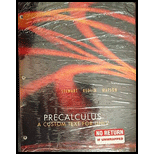
(a)
To evaluate: The expression
(a)
Answer to Problem 2T
The value of
Explanation of Solution
Given:
The expression is
Calculation:
In the given expression
Thus, the value of
(b)
To evaluate: The expression
(b)
Answer to Problem 2T
The value of
Explanation of Solution
Given:
The expression is
Calculation:
In the given expression 3 is the positive integer and 4 is the exponent of base 3 so the exponential notation is,
Thus, the value of
(c)
To evaluate: The expression
(c)
Answer to Problem 2T
The value of
Explanation of Solution
Given:
The expression is
Calculation:
In the given expression 3 is positive integer and
Thus, the value of
(d)
To evaluate: The expression
(d)
Answer to Problem 2T
The value of
Explanation of Solution
Given:
The expression is
Calculation:
The above expression shows that division of two powers of the same number so subtract the exponents,
Thus, the value of
(e)
To evaluate: The expression
(e)
Answer to Problem 2T
The value of
Explanation of Solution
Given:
The expression is
Calculation:
To raise a fraction to a negative power, invert the fraction and change the sign of the exponent in the above expression,
Thus, the value of
(f)
To evaluate: The expression
(f)
Answer to Problem 2T
The value of
Explanation of Solution
Given:
The expression is
Calculation:
Use exponential law to solve the given expression,
In the above solution of expression 2 is positive integer and
Thus, the value of
Chapter 1 Solutions
Precalculus - A Custom Text for UNLV
- A 20 foot ladder rests on level ground; its head (top) is against a vertical wall. The bottom of the ladder begins by being 12 feet from the wall but begins moving away at the rate of 0.1 feet per second. At what rate is the top of the ladder slipping down the wall? You may use a calculator.arrow_forwardExplain the focus and reasons for establishment of 12.4.1(root test) and 12.4.2(ratio test)arrow_forwarduse Integration by Parts to derive 12.6.1arrow_forward
- Explain the relationship between 12.3.6, (case A of 12.3.6) and 12.3.7arrow_forwardExplain the key points and reasons for the establishment of 12.3.2(integral Test)arrow_forwardUse 12.4.2 to determine whether the infinite series on the right side of equation 12.6.5, 12.6.6 and 12.6.7 converges for every real number x.arrow_forward
- use Corollary 12.6.2 and 12.6.3 to derive 12.6.4,12.6.5, 12.6.6 and 12.6.7arrow_forwardExplain the focus and reasons for establishment of 12.5.1(lim(n->infinite) and sigma of k=0 to n)arrow_forwardExplain the focus and reasons for establishment of 12.5.3 about alternating series. and explain the reason why (sigma k=1 to infinite)(-1)k+1/k = 1/1 - 1/2 + 1/3 - 1/4 + .... converges.arrow_forward
 Calculus: Early TranscendentalsCalculusISBN:9781285741550Author:James StewartPublisher:Cengage Learning
Calculus: Early TranscendentalsCalculusISBN:9781285741550Author:James StewartPublisher:Cengage Learning Thomas' Calculus (14th Edition)CalculusISBN:9780134438986Author:Joel R. Hass, Christopher E. Heil, Maurice D. WeirPublisher:PEARSON
Thomas' Calculus (14th Edition)CalculusISBN:9780134438986Author:Joel R. Hass, Christopher E. Heil, Maurice D. WeirPublisher:PEARSON Calculus: Early Transcendentals (3rd Edition)CalculusISBN:9780134763644Author:William L. Briggs, Lyle Cochran, Bernard Gillett, Eric SchulzPublisher:PEARSON
Calculus: Early Transcendentals (3rd Edition)CalculusISBN:9780134763644Author:William L. Briggs, Lyle Cochran, Bernard Gillett, Eric SchulzPublisher:PEARSON Calculus: Early TranscendentalsCalculusISBN:9781319050740Author:Jon Rogawski, Colin Adams, Robert FranzosaPublisher:W. H. Freeman
Calculus: Early TranscendentalsCalculusISBN:9781319050740Author:Jon Rogawski, Colin Adams, Robert FranzosaPublisher:W. H. Freeman
 Calculus: Early Transcendental FunctionsCalculusISBN:9781337552516Author:Ron Larson, Bruce H. EdwardsPublisher:Cengage Learning
Calculus: Early Transcendental FunctionsCalculusISBN:9781337552516Author:Ron Larson, Bruce H. EdwardsPublisher:Cengage Learning





